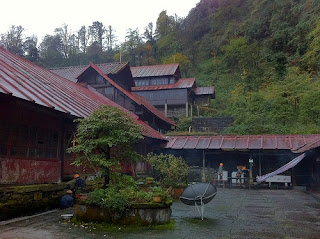Chapter Two
Mount Emei
Mt. Emei is located in Leshan City, Sichuan Province. It is the highest of China's four holy Buddhist mountains, rising 3,099m above sea level about 170km from Chengdu, Buddhists believe the mountain is home to Samantabbadra-patron of the Lotus Sutra and Bodhisattva of Pervading Goodness.
 |
| Mt. Emei |
The flower of the Chinese dove tree takes the shape of a pigeon, and when in full bloom, gives the impression of a flock of pigeons flying in and around the tree. The lesser panda and the gnu are just two of the rare animal species that live on the mountain.
It is towering, beautiful, old and mysterious. Mt. Emei is like a huge green screen standing in the southwest of the Chengdu Plain. Looking its winding and beautiful figure, you will find that it resembles very much an eyebrow of a girl. It is the highest one among all the famous sight-seeing mountains in China.
Mt. Emei is a sacred Buddhist site, and has a Buddhist history of over 1,500 years. It is said that during the 15th century, there were as many as 1,000 monks living on Mt. Emei. According to the records inscribed on a number of stone tablets, an eminent Indian monk came to spread the Buddhist doctrine as early as the 4th century. Later, Emperor Mingdi of the Eastern Han Dynasty ordered that Puguang Hall on the mountain be expanded into a temple, setting a precedent for the imperial court to construct temples on Mt. Emei.
From that time onwards, emperors of succeeding dynasties all endowed celebrated temples and eminent monks on the mountain with their gifts. Today, it still houses numerous relics of poems, couplets (written on scrolls and hung on the pillars of a hall), and inscriptions bestowed by emperors and scholars of ancient times.
In Mt. Emei there are four scenic regions: Baoguo Temple, Wannian Temple, Qingyin Pavilion and Golden Summit. Its main peak, the Golden Summit, is 3079.3 meters (10,103 feet) above the sea level, seemingly reaching the sky. Standing on the top of it, you can enjoy the snowy mountains in the west and the vast plain in the east.
In addition in Golden Summit there are four spectacles: clouds sea, sunrise, Buddha rays and saint lamps. In 1996 Mt. Emei was enlisted in the world natural and cultural heritage by the UNESCO.
★ Must-seeing Sights
1. Samantbhadra
 |
| Samantbhadra |
There were once more than a hundred temples and monasteries on the mountain, but only about twenty remain today, including the following better-known ones: Devotion to the Country Temple (Baoguosi), Ten-Thousand-Year Temple (Wanniansi), and Immortal Peak Temple (Xianfengsi), and the temple at Elephant Bath Pond (Xixiangchi)
2. Golden peak
 |
| Golden peak |
According to the old legend, Samantbhadra, Sakyamuni's disciple, once bathed his elephant in this pool before continuing his ascent of Mount Emei or, as others say, before flying to heaven on the elephant's back. Monkeys live in the vicinity; they often approach visitors to beg for food.
3. Immortal Peak Temple
 |
| Immortal Peak Temple |
Five kilometers downhill from Immortal Peak Temple, there stands the Clear Sound Pavilion (Qingyinge), another well-known scenic site on Mount Emei. Below Clear Sound Pavilion, there are Double Flying Pavilion (Shuangfeige) and Double Flying Bridge (Shuangfeiqiao).
The nearby White Dragon Cave (Bailongdong) is said to have been the place where Lady Bai Suzhen, a legendary nymph who was originally a white snake but later became a beautiful girl, cultivated her magic skills.

I'm pleased to receive your message.Could you tell me what your opinion about China tour? Please send email to contact@greatwalldiscovery.com if you have any question.Please keep in touch.
ReplyDelete